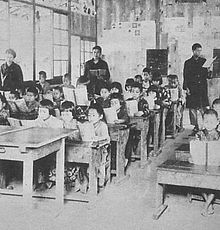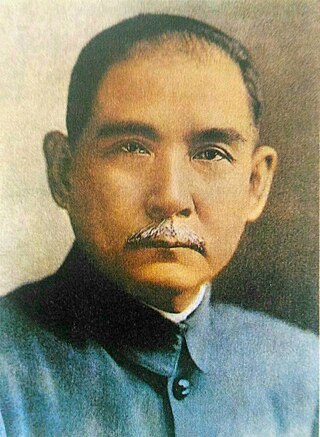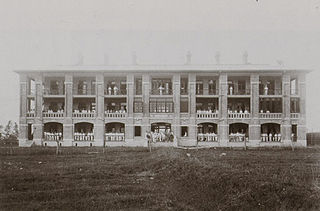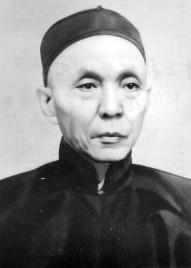| History of Taiwan | ||||||||||||||||
|---|---|---|---|---|---|---|---|---|---|---|---|---|---|---|---|---|
 | ||||||||||||||||
| Chronological | ||||||||||||||||
| ||||||||||||||||
| Topical | ||||||||||||||||
| Local | ||||||||||||||||
| Lists | ||||||||||||||||

The recorded history of education in Taiwan can be traced back to the Dutch colonial period.
| History of Taiwan | ||||||||||||||||
|---|---|---|---|---|---|---|---|---|---|---|---|---|---|---|---|---|
 | ||||||||||||||||
| Chronological | ||||||||||||||||
| ||||||||||||||||
| Topical | ||||||||||||||||
| Local | ||||||||||||||||
| Lists | ||||||||||||||||

The recorded history of education in Taiwan can be traced back to the Dutch colonial period.
In 1636, the Dutch started a school for the Sinckan people that not only featured religious instruction, but also provided schooling in Western literature. Because the Dutch advocated missionary work to be done in the native language, the school was taught in the Sinckan language. The missionary Robertus Junius recorded in his 1643 education report that the Sinckan school had enrolled 80 students, of which 24 were learning to write and 8 to 10 had solid penmanship, while in neighboring Baccaluan (modern-day Anding) school there were 90 students, of which 8 knew how to write.
Aside from proselytizing, the missionaries also compiled dictionaries and books of religious doctrine; they translated Gospel of Matthew into Sinckan and also compiled a vocabulary of Favorlang, another aboriginal language. These would become important sources for later research. The most important Sinckan documents were the contracts between the Sinckan and the Han settlers.
Under Qing dynasty rule, many traditional schools were established, mostly studying Chinese classics such as the teachings of Confucius. Education was limited to the children of well-to-do parents, as public and free schools did not exist. "Even the paid schools limited their instruction to the usual Chinese curriculum, which is devoted first to the study of the characters, and, if a higher education is desired, to the mastering of the Chinese classics...There were none of the studies which in western lands and in Japan are considered necessary for an educated man, and the general tendency of their training was to increase conservatism and love for ancient customs." [1]
During the Japanese period school attendance for Taiwanese children increased from 3.8% in 1904 to 71.3% in 1943 and literacy in Taiwan became common. [2] Modern schools were formed with widespread establishment of primary schools while higher schooling for Taiwanese people remained rare and secondary schools and colleges were mostly for Japanese nationals. In special cases Taiwanese did receive higher schooling and many went to Japan for further studies.
After Taiwan came under control of the Republic of China in 1945, education in Taiwan became a synthesis of the Japanese system and the Chinese system implemented by the Chinese Nationalist government. During the first 20 years of Chinese Nationalist rule, mandatory schooling consisted of six years of primary school education, which was also the length under Japanese rule. In 1968, this was extended to nine years.
After taking control of Taiwan, the Republic of China sought to remodel education on the island, a process that involved politicizing public schools and curtailing private ones. This became more urgent when the ROC and its Nationalist government exiled themselves to the island in 1949 to escape the Chinese Communist Party and the incipient People's Republic of China, which later model its education system aligning with the Soviet Union. Education reassumed a colonial dimension, this time to create a new national identity (a process referred to by Taiwanese scholar Ting-Hong Wong as “national colonialism”). In the late 1950s, the government yielded to pressure from both older Taiwanese communities and recent Mainlander immigrants, and enacted a series of education reforms, including the restoration of private schools (with measures taken to ensure their political loyalty). [3] Aspects of politicized education in Taiwan included a mandatory university level course, which had first been introduced by the Kuomintang in mainland China in 1944 as "party principles". The course later became known as the "Three Principles of the People". The Ministry of Education expanded the course to all levels of education in 1950, and renamed the university level course "Sun Yat-sen Thought" in 1964. The Council of Grand Justices ruled against mandatory university courses in 1995, and questions relating to Sun Yat-sen Thought were eventually removed from the General Scholastic Ability Test in 1999. [4]
Basic literacy came to most of the school-aged populace by the end of the Japanese tenure on Taiwan. School attendance for Taiwanese children rose steadily throughout the Japanese era, from 3.8 percent in 1904 to 13.1 percent in 1917; 25.1 percent in 1920; 41.5 percent in 1935; 57.6 percent in 1940; and 71.3 percent in 1943.
{{cite book}}: External link in |publisher=
Chiang Kai‐shek, also known as Jiang Zhongzheng and Jiang Jieshi, was a Chinese politician, revolutionary, and military leader who served as the leader of the Republic of China and the Generalissimo from 1928 to his death in 1975 – until 1949 in Mainland China and from then in Taiwan. Following the Kuomintang's defeat by the Chinese Communist Party in the Chinese Civil War, he continued to lead the ROC government in Taiwan until his death.

The Kuomintang (KMT), also referred to as the Guomindang (GMD), the Nationalist Party of China (NPC) or the Chinese Nationalist Party (CNP), is a major political party in the Republic of China, initially based on the Chinese mainland and then in Taiwan since 1949. It was the sole ruling party in China during the Republican Era from 1928 to 1949, when most of the Chinese mainland was under its control. The party retreated from the mainland to Taiwan on 7 December 1949, following its defeat in the Chinese Civil War. Chiang Kai-shek declared martial law and retained his authoritarian rule over Taiwan under the Dang Guo system until democratic reforms were enacted in the 1980s and full democratization in the 1990s. In Taiwanese politics today, the KMT is a centre-right to right-wing party and is the largest party in the Pan-Blue Coalition. The KMT's primary rival in elections is the Democratic Progressive Party (DPP) and its allies in the Pan-Green Coalition. As of 2023, the KMT is the largest opposition party in the Legislative Yuan. The current chairman is Eric Chu.

Sun Yat-sen was a Chinese revolutionary statesman, physician, and political philosopher who served as the first provisional president of the Republic of China and the first leader of the Kuomintang. He is called the "Father of the Nation" in the present-day Republic of China (Taiwan) and the "Forerunner of the Revolution" in the People's Republic of China for his instrumental role in the overthrow of the Qing dynasty during the 1911 Revolution. Sun is unique among 20th-century Chinese leaders for being widely revered by both the Communist Party in Mainland China and the Nationalist Party in Taiwan.

The Three Principles of the People is a political philosophy developed by Sun Yat-sen as part of a philosophy to improve China made during the Republican Era. The three principles are often translated into and summarized as nationalism, democracy, and the livelihood of the people. This philosophy has been claimed as the cornerstone of the nation's policy as carried by the Kuomintang; the principles also appear in the first line of the national anthem of Taiwan.
The history of the Republic of China begins after the Qing dynasty in 1912, when the Xinhai Revolution and the formation of the Republic of China put an end to 2,000 years of imperial rule. The Republic experienced many trials and tribulations after its founding which included being dominated by elements as disparate as warlord generals and foreign powers.

Sun Yat-sen University, also known as Zhongshan University, is a national public research university located in Guangzhou, Guangdong, China. It was founded in 1924 by and named after Sun Yat-sen, a revolutionary and the founder of the Republic of China. Its main campus, commonly referred to as the South Campus, is located in Haizhu District, Guangzhou, inheriting the campus from the former Lingnan University. The university has five campuses in the three cities of Guangzhou, Zhuhai and Shenzhen, and ten affiliated hospitals. It is a member of the nation's Double First Class University Plan, Project 985, and Project 211 for leading research universities.
The educational system in Taiwan is the responsibility of the Ministry of Education. The system produces pupils with some of the highest test scores in the world, especially in mathematics and science. Former president Ma Ying-jeou announced in January 2011 that the government would begin the phased implementation of a twelve-year compulsory education program by 2014.

The culture of Taiwan is a blend of Confucian Chinese and indigenous Taiwanese cultures. Despite the overwhelming traditional Chinese influence, Japanese culture has significantly influenced Taiwanese culture as well. The common socio-political experience in Taiwan gradually developed into a sense of Taiwanese cultural identity and a feeling of Taiwanese cultural awareness, which has been widely debated domestically.

Lingnan University in Guangzhou (Canton), China, was a private university established by a group of American missionaries in 1888. At its founding it was named Canton Christian College (格致書院).

The Sinkang Manuscripts are a series of leases, mortgages, and other commerce contracts written in the Sinckan, Taivoan, and Makatao languages. Among Han Chinese, they are commonly referred to as the "barbarian contracts". Some are written only in a Latin-based script, considered the first script to be developed in Taiwan itself, while others were bilingual with adjacent Han writing. Currently there are approximately 140 extant documents written in Sinckan; they are important in the study of Siraya and Taivoan culture, and Taiwanese history in general although there are only a few scholars who can understand them.

The Siraya people are a Taiwanese indigenous people. The Siraya settled flat coastal plains in the southwest part of the island of Taiwan and corresponding sections of the east coast; the area is identified today with Tainan City and Taitung County. At least four communities make up the group: Mattauw, Soelangh, Baccloangh, and Sinckan. The first four communities correspond to the modern-day districts of Madou, Jiali, Shanhua, and Sinshih, respectively.

The Nationalist government, officially the National Government of the Republic of China, also known as the Second Republic of China or simply as the Republic of China, refers to the government of the Republic of China from 1 July 1925 to 20 May 1948, led by the Kuomintang.

The island of Taiwan, together with the Penghu Islands, became a dependency of Japan in 1895, when the Qing dynasty ceded Fujian-Taiwan Province in the Treaty of Shimonoseki after the Japanese victory in the First Sino-Japanese War. The short-lived Republic of Formosa resistance movement was suppressed by Japanese troops and quickly defeated in the Capitulation of Tainan, ending organized resistance to Japanese occupation and inaugurating five decades of Japanese rule over Taiwan. The entity, historically known in English as Formosa, had an administrative capital located in Taihoku (Taipei) led by the Governor-General of Taiwan.
The Progressive Party was a political party in the Republic of China from 1913 to 1916.
The history of the Chinese Communist Party began with its establishment in July 1921. A study group led by Peking University professors Chen Duxiu and Li Dazhao to discuss Marxism, led to intellectuals officially founding the Chinese Communist Party (CCP) in July 1921. In 1923, Sun Yat-sen invited the CCP to form a United Front, and to join his Nationalist Party (GMD) in Canton for training under representatives of the Communist International, the Soviet Union's international organization. The Soviet representatives reorganized both parties into Leninist parties. Rather than the loose organization that characterized the two parties until then, the Leninist party operated on the principle of democratic centralism, in which the collective leadership set standards for membership and an all powerful Central Committee determined the party line, which all members must follow.

The Kuomintang (KMT) is a Chinese political party that ruled mainland China from 1927 to 1949 prior to its relocation to Taiwan as a result of the Chinese Civil War. The name of the party translates as "China's National People's Party" and was historically referred to as the Chinese Nationalists. The Party was initially founded on 23 August 1912, by Sun Yat-sen but dissolved in November 1913. It reformed on October 10th 1919, again led by Sun Yat-sen, and became the ruling party in China. After Sun's death, the party was dominated from 1927 to 1975 by Chiang Kai-shek. After the KMT lost the civil war with the Chinese Communist Party in 1949, the party retreated to Taiwan and remains a major political party of the Republic of China based in Taiwan.

The Republic of China (ROC), or simply China, was a sovereign state based in Mainland China from 1912 to 1949. It was first established on 1 January 1912, after being proclaimed in the 1911 Revolution against the Manchu-led Qing dynasty, and lasted until 7 December 1949, after its ruling party Kuomintang (KMT) was defeated by the Chinese Communist Party (CCP) at the de facto end of the Chinese Civil War, which resulted in a retreat of its central government to Taiwan, a territory which it took control of from the Empire of Japan in October 1945 after its surrender in World War II. The CCP-led People's Republic of China (PRC) then took over the governance of Mainland China with its capital in Beijing upon its establishment on 1 October 1949, while the ROC is now based on the island of Taiwan with its capital Taipei, where it retains actual rule over the Taiwan Area with the political status of Taiwan remaining in dispute to this day.

Wong Nai Siong (1849—1924) as a Chinese revolutionary leader and educator from Minqing county in Fuzhou, Fujian province, China. He served in The Methodist Episcopal Church for many years and participated in the "Ten Thousand Word Memorial" or the "Memorial of the Examination Candidates" Petition in 1895. He also took part in the Hundred Days' Reform in 1898 and the 1911 Xinhai Revolution which resulted in the founding of the Republic of China. Wong led people from Fujian province to migrate to Sibu, Sarawak.

Chiangism, also known as the Political Philosophy of Chiang Kai-shek, or Chiang Kai-shek Thought, is the political philosophy of President Generalissimo Chiang Kai-shek, who used it during his rule in China under the Kuomintang on both the mainland and Taiwan. It is a right-wing authoritarian nationalist political ideology which is based on mostly Confucian and Tridemist ideologies, and was used in the New Life Movement in China and the Chinese Cultural Renaissance movement in Taiwan. It is a syncretic mix of many political ideologies, including revolutionary nationalism, Tridemism, socialism, militarism, Confucianism, state capitalism, constitutionalism, fascism, authoritarian capitalism, and paternalistic conservatism, as well as Chiang's Methodist Christianity.
The 1952 reorganisation of Chinese higher education was a national policy under the Chinese Communist Party (CCP), which came into power in 1949, to adopt Soviet-styled higher education, which focused more on engineering education and technical training, in mainland China and to remove American influences among Chinese scholars. While eliminating private education, especially missionary higher education, the policy led to the state control over the higher education sector and the loss of faculty governance tradition since the 1920s. This served the Communist agenda to break up the prestigious universities established under the Republic of China, to weaken the historical ties between the university and the faculty, and to establish the political and organisational authority of the new Communist government over the higher education system. The reorganisation involved most of the higher education institutions in mainland China and influenced the basic structure of Chinese higher education today.